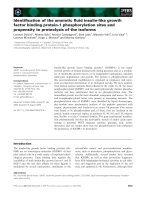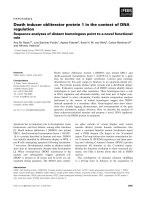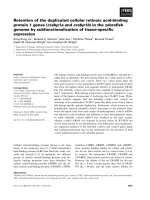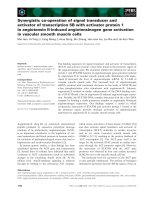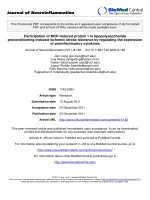Proline rich acidic protein 1 in life and death 2
Bạn đang xem bản rút gọn của tài liệu. Xem và tải ngay bản đầy đủ của tài liệu tại đây (386.04 KB, 96 trang )
i
ACKNOWLEDGEMENTS
I would like to express my gratitude to the following people for their
contribution and for making this project possible:
My main supervisor, Associate Professor Hooi Shing Chuan, for his
valuable guidance and persistent support, without which, this thesis would not
have been produced in the present form. I am grateful for the many opportunities
given to me in exploring the area of research in molecular biology. I have learnt
much in the past six years that I have spent in this laboratory.
Assistant Professor Bernard Leung for his unfailing support, technical
guidance, patience, and for providing his expertise in the work on SLE.
Associate Professor Manuel Salto-Tellez of Pathology Department for his
kind guidance and for providing his expertise in the histopathological analysis of
human intestinal tissues.
The wonderful present and past members of the Cancer Metastasis &
Epigenetic Laboratory: Dr Liu Jian-Jun, for his stimulating discussions, valuable
guidance and his contribution in the work on differentiation; Colyn, for her
contributions in the work of bacteria binding, phagocytosis, pulldown assay,
isolation and treatment of PBMCs; Jasmine, for her contribution in the
antibacterial activity assay; Carol, Mirtha, Pui Nam, Yu Hong, Guo Hua, Guo
Dong, Ganesan, Yun Tong, Jin Qiu, and Tamil for their advice and support. Thank
you all for your wonderful friendship and for making my stay in this laboratory
truly enjoyable.
ii
Special thanks to the following people for their much appreciated and
valuable input in proofreading this thesis: Koh Shiuan, Sufen, Seehee and Kah
Weng .
To all staff and students of the Department of Physiology, NUS, for their
advice, support and friendship.
To the Administration and Support Team of Physiology Department for
their kind assistance and friendship. Special thanks to Asha for her support in
arranging all the meetings and many other administrative works.
To past and present members of NUMI Confocal and Flow Cytometry
Units, for their kind assistance.
To my friends, Seehee, Suli and Jaws for their unfailing friendship and
support throughout this course.
Last but not least, to my parents and siblings, for their love, understanding,
care and support throughout my study.
And above all, all glory to God for His unfailing grace, mercy and love,
and for granting me strength in Him to complete this course.
SOLI DEO GLORIA
iii
TABLE OF CONTENT
ACKNOWLEDGEMENTS i
TABLE OF CONTENT iii
SUMMARY xii
LIST OF TABLES xiv
LIST OF FIGURES xv
ABBREVIATIONS xx
CHAPTER ONE 1
INTRODUCTION 1
1.0 Objectives of the study 2
1.1 Gastrointestinal tract 6
1.1.1 Biology of intestinal mucosa 6
1.1.2 Mechanism of epithelium renewal 7
1.2 Intestinal immune system 9
1.2.1 Innate immunity 9
1.2.2 Structure of defensins 10
1.2.3 Mechanism of antimicrobial activity 11
1.2.4 Human alpha- and beta-defensins 11
1.3.1 Incidence, staging and survival rate of colorectal cancer 12
1.3.2 Classification of colorectal cancer 15
1.3.4 Treatment of colorectal cancer 17
1.3.4.1 Surgical resection 17
1.3.4.2 Chemotherapy 17
1.3.4.2.1 Mechanism of action of 5-FU 21
iv
1.4 Tumor suppressors in colorectal cancer development 23
1.4.1 p53 23
1.4.2 DNA mismatch repair genes 25
1.5 Cell cycle checkpoints 27
1.5.1 The cell cycle complexes 27
1.5.2 CDK inhibitors 28
1.5.3 G1-S checkpoint 28
1.5.4 G2 checkpoint 29
1.6 Apoptosis 30
1.6.1 Caspase-dependent apoptosis 30
1.6.2 Clearance of apoptotic cells 31
1.7 Systemic Lupus Erythematosus 35
1.7.1 Role of autoantibodies 36
1.7.2 Impairment of apoptotic cell removal 37
CHAPTER TWO 39
MATERIALS AND METHODS 39
2.1 Cell lines and cell culture 40
2.1.1 Cell lines 40
2.1.1.1 PBMCs 40
2.1.1.2 Cell culture 41
2.1.2 Treatment of cells 41
2.1.2.1 Treatment of human colon cancer cells HT 29 with sodium butyrate 41
2.1.2.2 Treatment of human colon cancer cells HT 29 with glucose free medium41
2.1.2.3 Treatment of human colon cancer cells LS174T with dnTCF 42
v
2.1.2.4 Treatment of human colon cancer cells HCT 116 with genotoxic stressors
42
2.1.2.5 Treatment of HCT 116 cells with Nocodazole and Taxol 43
2.1.2.6 Treatment of HCT 116 cells with thymidine 43
2.1.2.7 Treatment of HCT 116 cells with caspase inhibitors 43
2.1.2.8 Treatment of human lymphocyte cell lines with UV 44
2.1.2.9 Treatment of PBMCs with gentoxic agents 44
2.1.2.10 Treatment of Jurkat cells with PHA/PMA 44
2.1.2.11 Treatment of U937 with PMA 45
2.1.3 Transient Transfection 45
2.1.3.1 Transient Transfection of plasmids 45
2.1.3.2 Transient transfection and dual-luciferase reporter assay 45
2.1.3.4 Transient transfection of siRNAs 46
2.2 Survival Assay 46
2.2.1 Colony formation assay 46
2.2.2 Propidium Iodide Staining 46
2.2.3 Annexin-V staining 47
2.2.4 Assay activities of caspase 3 47
2.3 RT-PCR 48
2.3.1 RNA isolation 48
2.3.2 cDNA synthesis 49
2.3.3 PCR reaction 49
2.3.4 Real-time PCR 49
2.3.5 Probe-based real-time RT-PCR 50
2.4 Cloning 51
vi
2.4.1 DNA fragment purification by gel extraction 51
2.4.2 Restriction digestion 52
2.4.3 Ligation 52
2.4.4 Transformation 52
2.4.5 Plasmid miniprep 53
2.4.6 Plasmid midiprep 53
2.4.7 Sequencing reactions 54
2.4.8 Cloning of PRAP1 gene into mammalian and prokaryotic expression
vectors 55
2.4.9 Cloning of PRAP1 promoter 55
2.4.10 Cloning of PRAP1 p53 binding elements 57
2.5 ELISA 58
2.5.1 Detection of anti-PRAP1 auto-antibody in serum 58
2.5.2 Detection of PRAP1 antigen in serum 58
2.5.3 Detection of cytokines 59
2.5.4 Cell-cell contact assay for cytokine production 59
2.6 Expression and purification of PRAP1 recombinant protein 60
2.6.1 Expression of GST-PRAP1 60
2.6.2 Purification of GST-PRAP1 protein 61
2.6.3 Expression and purification of His-tagged PRAP1 protein 61
2.7 Generation and purification of polyclonal antibody 62
2.8 Protein-protein interaction assay 64
2.8.1 Pulldown Assay 64
2.8.2 Immunoprecipitation 64
2.9 Immunodetection assay 65
vii
2.9.1 Immunohistochemistry 65
2.9.2 Immunofluorescence microscopy 66
2.9.3 Scanning Electron microscopy 67
2.9.4 Western blotting 67
2.9.4.1 Protein extraction 67
2.9.4.2 Bio-Rad protein assay 68
2.9.4.3 SDS PAGE 69
2.9.4.4 Immunodetection 69
2.9.5 Immunodetection of anti-PRAP1 auto-antibody in serum 70
2.10 Bacteria binding assay 70
2.10.1 Detection by ELISA 70
2.10.2 Detection by direct binding 71
2.10.2.1 Labeling of protein with Alexa Fluor dye 71
2.10.2.2 Bacteria binding assay using labeled protein 71
2.11 DNA damage assay 72
2.11.1 Alkaline single-cell gel electophoresis (comet) assay 72
2.11.2 Micronucleus assay 73
2.12 Phagocytosis assay 73
2.12.1 Preparation of fluorescent beads 73
2.12.2 In vitro phagocytosis 73
2.13 Statistical Analysis 74
CHAPTER THREE 75
RESULTS 75
3.1 PRAP1 and intestinal differentiation 76
3.1.1 PRAP1 is expressed in epithelial cells of the intestines 76
viii
3.1.2 Induction of PRAP1 by WNT-TCF pathway inhibition 79
3.1.3 Induction of PRAP1 by sodium butyrate 79
3.1.4 Induction of PRAP1 by glucose deprivation 82
3.2 Regulation of PRAP1 expression by differentiation 82
3.2.1 Induction of PRAP1 expression at mRNA level 82
3.2.2 Transcriptional regulation of PRAP1 85
3.2.2.1 Promoter characterization of PRAP1 85
3.2.2.2 PRAP1 expression was not regulated at transcriptional level 87
3.2.3 PRAP1 mRNA was stabilized in cellular differentiation 87
3.3 Effect of PRAP1 on differentiation 90
3.3.1 Effect of PRAP1 overexpression on cellular differentiation 90
3.3.2 Effect of PRAP1 knockdown on cellular differentiation 90
3.4 Role of PRAP1 in differentiated epithelial cells 93
3.4.1 PRAP1 binds bacteria 93
3.4.2 Bactericidal activity of PRAP1 95
3.4.3 Phagocytosis of bacteria 97
3.5 PRAP1 is a genotoxic stress responsive gene 97
3.5.1 Induction of PRAP1 by stressors that cause DNA damage 97
3.5.2 Transcriptional regulation of PRAP1 by genotoxic agents 99
3.5.3 Regulation of PRAP1 protein by genotoxic agents 102
3.5.4 Dose- and time-dependent regulation of PRAP1 105
3.6 Wild-type-p53-dependent induction of PRAP1 105
3.6.1 Genotoxic agents failed to induce PRAP1 in p53-/- cells 105
3.6.2 Restoration of PRAP1 induction by reintroduction of wild-type p53 in
p53-/- cells 107
ix
3.6.3 Genotoxic agents failed to induce PRAP1 in Hep 3B and HT 29 cells
107
3.7 PRAP1 is a novel p53-responsive gene 109
3.7.1 Identification of p53-response elements in PRAP1 gene 109
3.7.2 p53-response elements in PRAP1 gene are responsive to wild-type p53
113
3.8 PRAP1 modulates cell fate after genotoxic stress 113
3.8.1 Repression of PRAP1 induction by siRNAs 113
3.8.2 Effect of PRAP1 knockdown on colony formation 115
3.8.3 Effect of PRAP1 knockdown on sub-G1 118
3.8.4 Effect of PRAP1 knockdown on DNA damage 118
3.9 PRAP1 and cell cycle checkpoints 121
3.9.1 Enhanced cell death is accompanied by abrogation of S-phase arrest 121
3.9.2 Effect of PRAP1 knockdown on cyclins and CDKs 121
3.9.3 Effect of PRAP1 knockdown on cell cycle checkpoint proteins 124
3.9.4 Effect of PRAP1 knockdown on p53 level 127
3.9.5 PRAP1 expression was up-regulated in cells arrested at S-phase 127
3.9.6 PRAP1 inhibition in double-thymidine block assay 128
3.9.7 PRAP1 overexpression and cell cycle 129
3.9.8 PRAP1 knockdown in p53-/- cells 129
3.10 Mechanism of the cell death induced by PRAP1 inhibition 133
3.10.1 5-FU induced cell death is via a caspase-dependent mechanism 133
3.10.2 Inhibition of PRAP1 induces caspase-dependent apoptosis in cells
treated with 5-FU 136
x
3.11 Other mechanisms employed by PRAP1 inhibition is enhancing cell death
138
3.11.1 Effect of PRAP1 on cytoskeleton 138
3.11.1.1 Effects of PRAP1 on cellular morphology 138
3.11.1.2 Effects PRAP1 on actin filament 139
3.11.1.3 Effects of PRAP1 on microtubules 141
3.11.2 PRAP1 interacts with Hsp 70 141
3.12 Role of PRAP1 in apoptotic cells 145
3.12.1 Induction of PRAP1 expression in apoptotic cells 145
3.12.2 PRAP1 binds to the surface of apoptotic cells 147
3.12.3 PRAP1 enhanced the phagocytosis of beads 153
3.13 Role of PRAP1 in a disease model, SLE 156
3.13.1 Detection of PRAP1 autoantigen 156
3.13.2 Detection of PRAP1 autoanitbodies 158
3.13.3 PRAP1 and proinflammatory cytokines 158
3.13.4 PRAP1 expression in PBMC 161
3.14 Regulation of PRAP1 expression in lymphocytes 165
3.14.1 PRAP1 is induced by PHA/PMA 165
3.14.2 PRAP1 is induced by UV 165
3.14.3 PRAP1 is induced by cytotoxic drugs 167
3.14.4 Regulation of PRAP1 expression in PBMC by cytotoxic drugs 167
CHAPTER FOUR 172
DISCUSSION 172
4.1 Role of PRAP1 in differentiated epithelial cells 173
4.1.1 Regulation of PRAP1 by differentiation 173
xi
4.1.1.1 Expression of PRAP1 in intestinal epithelium 173
4.1.1.2 PRAP1 expression is positively correlated with differentiation 175
4.1.1.3 Regulation of PRAP1 expression by differentiation 177
4.1.2 Effect of PRAP1 on differentiation 178
4.1.3 PRAP1 and innate immunity 179
4.2 PRAP1, a p53-inducible modulator of cell fate in response to genotoxic
stress 182
4.2.1 PRAP1 is a genotoxic responsive gene 182
4.2.2 PRAP1 is a p53 responsive gene 184
4.2.3 PRAP1 modulates cell fate in response to genotoxic stress 186
4.2.4 Role of PRAP1 in cell cycle checkpoints 188
4.3 Role of PRAP1 in SLE 192
4.3.1 Induction of PRAP1 in apoptotic cells 192
4.3.2 Genotoxic agents failed to induce PRAP1 in PBMCs from SLE patients
193
CHAPTER FIVE 197
CONCLUSION 197
CONCLUSION 198
REFERENCES 200
APPENDIX I 213
APPENDIX II 218
xii
SUMMARY
The Proline-rich acidic protein (PRAP1) was initially identified as a gene
that was differentially expressed in pregnant mouse uterus. The rat and human
homologues were subsequently identified and found to be expressed abundantly in
the gastrointestinal tract. This thesis describes the characterization of the
physiological role of human PRAP1 in the gastrointestinal tract and its possible
role(s) in pathological states. Broadly, PRAP1 has functions in two contrasting
settings: life and death.
The expression of PRAP1 is significantly correlated with the degree of
differentiation of gastrointestinal epithelial cells. In addition, PRAP1 is secreted
into the gastrointestinal lumen and binds to the surface of bacteria. It demonstrates
bactericidal activity and may aid bacterial phagocytosis. In colorectal cancer
(CRC), PRAP1 is a downstream target of p53 and plays a protective role against
genotoxic stressors. Repression of PRAP1 significantly enhances the anti-tumor
effect of chemotherapeutic drugs used in the treatment of CRC. This is partly
mediated through the abrogation of S-phase arrest in a p53 dependent manner,
resulting in increased DNA damage and activation of the apoptotic pathway over
cell cycle arrest. Taken together, these imply that PRAP1 functions to maintain
cell viability. Conversely, there is also a possible role of PRAP1 during cell death
in facilitating the removal of apoptotic cells. PRAP1 binds to the surface of
apoptotic cells and may facilitate the clearance of apoptotic cells, the derangement
of which may lead to systemic lupus erythematosus (SLE).
In conclusion, PRAP1 is a multifunction protein with antimicrobial and
cell fate modulation properties playing the contrasting roles of promoting cell
xiii
survival and cell death, which presents a novel target in the treatment of CRC and
SLE.
xiv
LIST OF TABLES
Table 1.1 Definition of the T staging of the TNM classification. 14
Table 1.2 Definition of the N and M staging of the TNM classification. 15
Table 1.3 The five-year survival rate of 120,000 people diagnosed with colon
cancer between 1991 and 2000. 15
Table 1.4 Survival statistics for adenocarcinoma of the colon in Singapore. 15
Table 1.5 Categories of drugs used in the management of colorectal cancer. 19
Table 1.6 Commonly used bolus and infusional regimens used to administer 5-
FU/LV chemotherapy. 20
Table 1.7 Molecules implicated in apoptotic cell uptake. 32
Table 2.1 Primer sequences for cloning of PRAP1 promoter 56
Table 2.2 Long template PCR system reaction mix 56
Table 2.3 Long Template PCR parameters 57
Table 2.4 Restriction digestion of vector 57
Table 2.5 Ligation reaction 57
Table 3.11 Sequences of the two p53 binding sites located in PRAP1 gene 111
xv
LIST OF FIGURES
Figure 1.1 Sequences and the disulphide pairing of cysteines 10
Figure 1.2 Genetic model of colorectal carcinogenesis 16
Figure 1.3 Mechanism of action of 5-FU 23
Figure 1.4 DNA Damage Response 26
Figure 1.5 Regulation of cyclins 28
Figure 3.11 PRAP1 is expressed in the epithelial cells of small intestine 77
Figure 3.12 PRAP1 is expressed in the epithelial cells of colon 78
Figure 3.13 Differentiation is induced by blocking TCF4 80
Figure 3.14 PRAP1 is induced in differentiated colorectal cancer cells 80
Figure 3.15 PRAP1 expression is induced by sodium butyrate 81
Figure 3.16 PRAP1 expression is correlated with differentiation 81
Figure 3.17 PRAP1 expression is induced by glucose deprivation 83
Figure 3.18 PRAP1 expression is induced at mRNA level by differentiation 84
Figure 3.19 Cloning of PRAP1 promoter 84
Figure 3.20 PRAP1 promoter activities in L8 cells 86
Figure 3.21 PRAP1 is not regulated at transcriptional level by differentiation 88
Figure 3.22 Stability of PRAP1 mRNA is increased by differentiation 89
Figure 3.23 Overexpression of PRAP1 do not induce differentiation in HT 29 91
Figure 3.24 Overexpression of PRAP1 do not induce differentiation in L8 cells . 92
Figure 3.25 Repression of PRAP1 expression did not affect differentiation in L8
cells 92
Figure 3.26 Purity of HisPRAP1 protein 94
Figure 3.27 HisPRAP1 binds to E.coli 94
Figure 3.28 HisPRAP1 binds to E.coli and Klebsiella 96
xvi
Figure 3.29 Bactericidial activity of HisPRAP1 at pH 4.5 96
Figure 3.30 Phagocytosis of E.coli 98
Figure 3.31 PRAP1 is induced by genotoxic stressors 100
Figure 3.32 Luciferase assay to identify the regions required for the prap1 gene
promoter activity in HCT 116 cells 101
Figure 3.33 Identification of core promoter of prap1 gene 101
Figure 3.34 Induction of prap1 promoter activity by 5-FU and CPT 103
Figure 3.35 Induction of PRAP1 by 5-FU and CPT at mRNA level 104
Figure 3.36 PRAP1 was induced at protein level by 5-FU and CPT 104
Figure 3.37 Early upregulation of PRAP1 in a dose- and time-dependent manner
106
Figure 3.38 Early upregulation of PRAP1 protein by 5-FU and CPT 106
Figure 3.39 Induction of prap1 by 5-FU and CPT is dependent on p53 108
Figure 3.40 Reintroduction of wild-type p53 rescues the induction of prap1 by 5-
FU and CPT in p53-/- cells 108
Figure 3.41 Hep 3B and HT 29 cells failed to induce prap1 gene expression 110
Figure 3.42 Schematic diagram of PRAP1 gene 111
Figure 3.43 Schematic diagram of p53 binding site of PRAP1 gene construct 112
Figure 3.44 Verification of the p53 binding sites constructed plasmid 112
Figure 3.45 Predicted p53 binding elements of PRAP1 response to wild-type p53
114
Figure 3.46 Suppression of PRAP1 induction by 5-FU at mRNA level 116
Figure 3.47 Suppression of PRAP1 induction by 5-FU at protein level 116
Figure 3.48 Repression of PRAP1 expression reduces colony numbers 117
Figure 3.49 Summary of the number of colonies formed 117
xvii
Figure 3.50 Repression of PRAP1 expression enhances the cell death induced by
5-FU 119
Figure 3.51 Repression of PRAP1 expression enhances 5-FU induced DNA
damage measured by comet assay 120
Figure 3.52 Repression of PRAP1 expression enhances 5-FU induced DNA
damage as measured by micronuclei assay 120
Figure 3.53 Repression of PRAP1 expression results in morphological changes
122
Figure 3.54 Repression of PRAP1 expression abrogates the S-phase arrest induced
by 5-FU 123
Figure 3.55 Repression of PRAP1 expression reduces cyclin A1 125
Figure 3.56 PRAP1 knockdown reduces CDK2 125
Figure 3.57 Repression of PRAP1 expression affects p21 localization 126
Figure 3.58 PRAP1 was upregulated in S-phase arrested cells 128
Figure 3.59 Abrogation of the S-phase arrest in double-thymidine block 130
Figure 3.60 Overexpression of PRAP1 alone failed to induce S-phase arrest 131
Figure 3.61 Repression of PRAP1 in p53-/- cells failed to abrogate S-phase arrest
132
Figure 3.62 Repression of PRAP1 in p53-/- cells failed to enhance cytotoxicity of
low dose of 5-FU 132
Figure 3.63 Treatment of p53-/- cells with high dose of 5-FU 134
Figure 3.64 5-FU induces caspase-dependent apoptosis in HCT 116 135
Figure 3.65 Repression of PRAP1 induces caspase 3 activity in 5-FU treated cells
135
Figure 3.66 Repression of PRAP1 enhances caspase-dependent apoptosis 137
xviii
Figure 3.67 Effects of PRAP1 on actin network 140
Figure 3.68 Effects of PRAP1 on microtubulin network 142
Figure 3.69 GST-PRAP1 pull-down 143
Figure 3.70 Identification of PRAP1 binding protein by MS-MS 144
Figure 3.71 PRAP1 physically interacts with Hsp 70 144
Figure 3.72 Dying cells in floating population 146
Figure 3.73 Apoptotic cells in floating population 148
Figure 3.74 PRAP1 expression is increased in apoptotic cells 148
Figure 3.75 Immunofluorescence images showing the binding of PRAP1 to the
surface of apoptotic cells 150
Figure 3.76 Histogram showing PRAP1 binds to the surface of apoptotic cells . 150
Figure 3.77 PRAP1 binds on the surface of HCT 116 apoptotic cells 151
Figure 3.78 Alexa fluor labeled HisPRAP1 binds directly to the surface of
apoptotic cells 151
Figure 3.79 Transmission electron microscopy of PRAP1 on apoptotic cells 152
Figure 3.80 Flow cytometry analysis of phagocytosis of beads by U937 154
Figure 3.81 HisPRAP1 enhances phagocytosis of beads by macrophages 155
Figure 3.82 PRAP1 protein was detected in the serum of both normal and SLE
patients 157
Figure 3.83 PRAP1 autoantibody was detected in serum 159
Figure 3.84 Verification of PRAP1 autoantibodies in the serum 160
Figure 3.85 Effects of low concentration of HisPRAP1 protein on the production
of proinflammatory cytokines 162
Figure 3.86 Effects of high concentration of PRAP1 on the production of
proinflammatory cytokines 163
xix
Figure 3.87 PRAP1 mRNA expression is reduced in SLE patients 164
Figure 3.88 PRAP1 expression is induced by PHA/PMA 166
Figure 3.89 PRAP1 expression is induced by UV 166
Figure 3.90 PRAP1 expression is induced by cytotoxic drugs in lymphocytes 168
Figure 3.91 PRAP1 is induced in normal PBMC by cytotoxic drugs 169
Figure 3.92 PBMCs from SLE patients failed to induce PRAP1 169
Figure 3.93 PBMCs from SLE patients failed to induce PRAP1 mRNA 170
xx
ABBREVIATIONS
5-FU
5-fluorouracil
Ab
antibody
Ag
antigen
APC
adenomatous polyposis coli
BFA
Brefeldin A
bp
base pair
BSA
bovine serum albumin
CDK
cyclin-dependent kinase
cDNA
complementary deoxyribonucleic acid
CHAPS
3-[(3-cholamidopropyl1)dimethyammonio]-1-
propanesulphonate
CLL
chronic lymphocytic leukemia
CPT
camptothecin
CRC
colorectal cancer
DMSO
dimethyl sulfoxide
DNA
deoxyribonucleic acid
dnTCF
dominant negative TCF
dNTP
deoxyribonucleotide triphosphate
dsDNA
double stranded DNA
DTT
dithioreitol
EDTA
ethylenediaminetetraacetic acid
ELISA
enzyme linked immunosorbent assay
xxi
ER
endoplasmic reticulum
Eto
etoposide
FAP
familial adenomatous polyposis
FBS
fetal bovine serum
FITC
fluorescein isothiocyanate
GST
glutathione S-transferase
HD
human defensin
HDAC
histone deacetylase
HEPES
4-(2-hydroxyethyl)-1-piperazineethanesulfonic acid
HSP
heat shock protein
IgG
immunoglobulin
IL
interleukin
IPTG
isopropyl-β-D-thiogalactoside
Kd
kilo Daltons
LB
Luria-Bertani
mRNA
messenger RNA
Mut
mutant
Nab
natural antibody
NaCl
sodium cholride
PBMC
peripheral blood mononuclear cell
PBS
phospate buffered saline
PBST
PBS-Tween
PCR
polymerase chain reaction
PHA
phytohaemagglutinin
PMA
phorbol 12-myristate 13-acetate
xxii
PMSF
phenylmethylsulfonyl fluoride
RNA
ribonucleic acid
RT-PCR
reverse transcriptase polymerase chain reaction
SD
standard deviation
SDS
sodium deodecyl sulphate
SDS-PAGE
SDS-polyacrylamide gel electrophoresis
SEM
standard error of the mean
siRNA
small interference RNA
SLE
systemic lupus erythematosus
TBE
tris-borate EDTA
TCF
T-cell factor
TNF
tumor necrosis factor
UTR
untranslated region
UV
ultraviolet
V
voltage
WT
wild type
M
molar
mM
millimolar
mg
milligram
mL
milliliter
μg
microgram
μL
microliter
μm
micrometer
μM
micromolar
ng
nanogram
nM
nanomolar
pg
picogram
1
CHAPTER ONE
INTRODUCTION
2
1.0 Objectives of the study
Proline rich acidic protein gene (PRAP1) was first identified in the mouse
(Kasik and Rice 1997). The gene was expressed in the mouse uterus from day 12
of gestation to the third day after parturition. Later, our group investigated the rat
homologue of PRAP1, and showed that the expression of PRAP1 in rat was not
limited to late pregnant uterus. There was abundant expression in the mucosa of
gastrointestinal tracts of mouse and rat (Zhang, Rajkumar et al. 2000). The human
homologue of PRAP1 was subsequently isolated and characterized (Zhang, Wong
et al. 2003) by our group. Human PRAP1 was also found to be abundantly
expressed in the epithelial cells of the gastrointestinal tract and cervix. In contrast
to mouse and rat, human PRAP1 was not restricted to the gastrointestinal tract, but
was also found in the hepatocytes of the liver, and proximal and distal renal
tubules. The significance of the species-specific localization of PRAP1 remains
unknown, but it may suggest that PRAP1 have different functions in different
species and organ systems.
Both human and rodents have PRAP1 expression in epithelial cells of the
gastrointestinal tract, suggesting that PRAP1 may be associated with epithelial
cell differentiation. PRAP1 was also used as a differentiation marker by other
studies (Zhang, Wong et al. 2003; Tou, Liu et al. 2004). However, its functional
role in the differentiation process has not been elucidated. Hence, the first main
objective of this study is to further validate the association of PRAP1 with
intestinal differentiation and its possible role in the process of differentiation. To
achieve this, the following issues were examined:
1. expression pattern and localization of PRAP1 in normal human
small intestine and colon using immunohistochemical staining
3
2. correlation of PRAP1 expression with three well-characterized
differentiation models, namely WNT/TCF pathway, glucose
deprivation and sodium butyrate
3. effect of perturbing PRAP1 expression on the differentiation
process
Beyond expression in physiological states, our group has previously found
that PRAP1 expression was regulated epigenetically and was down-regulated in
right-sided colon adenocarcinoma when compared with the respective adjacent
normal tissues. Furthermore, overexpression of PRAP1 was reported to inhibit the
growth of colon cancer cell lines (Zhang, Wong et al. 2003), suggesting that
PRAP1 may play a negative regulatory role in the development of colorectal
cancer.
Colorectal cancer is the world's third commonest cancer, and second most
common cancer in Singapore. There is an increasing understanding of the
molecular pathology of this cancer of the large bowel. Primarily, the diagnosis of
colon cancer is made through colonoscopy with biopsy. The mainstay of treatment
is removal of the tumor by surgery, followed by adjuvant chemotherapy.
The chemotherapeutic agent, 5-Fluorouracil (5-FU) has been used as the
first-line therapy for advanced colorectal cancer and as adjuvant therapy for early
colorectal cancer ever since it was first discovered 40 years ago (Poon, O'Connell
et al. 1989; Giacchetti, Perpoint et al. 2000; Gill, Loprinzi et al. 2004). However,
in patients with advanced colorectal cancer, only a subset of tumors responded to
5-FU (10 to 15%, Johnston and Kaye 2001). Although its enzymatic conversion
and metabolism are well defined, the cellular factors that determine the sensitivity
or resistance to this drug remain poorly understood. Hence, finding new genes and
